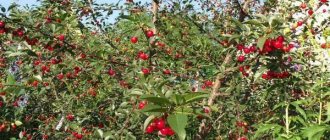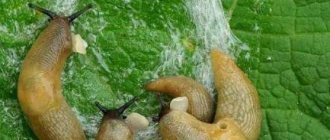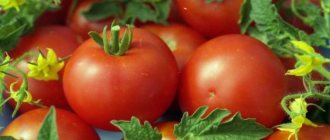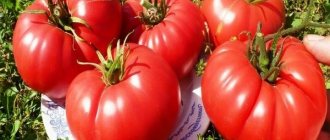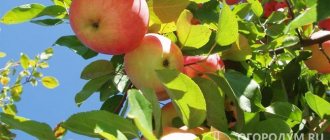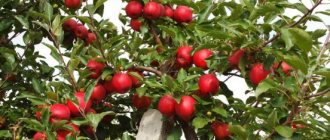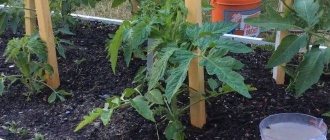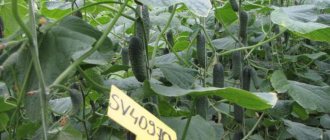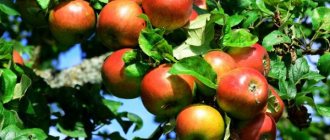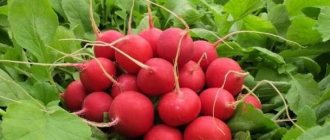Botanical characteristics
The Gloucester variety is of German origin. It was introduced in 1951, and soon gained great popularity in European countries. In particular, he showed himself excellently in Ukraine and in the southern regions of Russia. The Gloucester tree exhibits strong growth and forms a pyramidal or oval medium-dense crown. The height reaches 8 m. It begins to bear fruit from 4 years after planting, and on dwarf rootstocks - from 2-3 years. Flowering is mid-late and long-lasting.
Did you know? Apples do not sink in water, due to the fact that a quarter consists of air.
The variety is capable of self-pollinating, but in general pollination is mixed and the presence of pollinators increases the yield well. The best pollinators are Idared, Jonathan, Gala, James Grieve, and Spartan apple trees. The average fruit weight is 160 g, but they can reach 200 g. They have a round-conical shape with slight ribbing in the upper part. The cover color of a dark crimson-red color almost completely covers the main yellowish color of the apple. Under the smooth shiny skin, light subcutaneous specks are visible.
Gloucester apple trees are highly valued by gardeners throughout Europe. The fruits are juicy and have light green flesh, which acquires a creamy tone during storage. It has a sweet taste with a slight sourness, rated 4.5 points. The taste of the fruit is best expressed in the southern regions. Ripening occurs at the end of September. The taste becomes most pronounced by January, and the apples themselves can retain their quality until May. From an adult apple tree, 35–75 kg of harvest is harvested. Gloucester is resistant to powdery mildew and weakly resistant to scab. Can tolerate frosts down to -25°C.
Unpretentious Gloucester apple tree: description of the variety with photos - growing features
The Gloucester Apple tree variety produces tasty and appetizing apples, but it took a lot of trouble to care for.
Who knew that this fruit tree cannot pollinate on its own? Therefore, for several years we were literally left with nothing, that is, without a harvest. Then I had to look for an error in agricultural technology. The answer was given by experienced gardeners on forums on the Internet. Now I have a decent amount of knowledge about the apple tree behind me. I share my findings with you in this review.
The amazingly beautiful Gloucester apples were developed by German scientists. Breeders crossed Richard Delicious and Glockenapfel. Since 1951, the new product has been tested in Western European countries. Then the variety began to be cultivated in the northern regions, including the steppes.
Within a few years, the seedling reaches the size of an adult plant. The height of the tree is 2.5 meters, diameter is 3 meters. If the crown of a young tree has an oval or pyramidal shape, then of an adult it is round.
Advantages and disadvantages of the variety
- Gardeners value this variety for the following advantages:
- excellent keeping quality of fruits;
- precocity;
- stability of yields;
- apples tolerate transportation well;
- beautiful presentation of the fruit;
- excellent taste;
- good disease resistance.
- Commonly recognized disadvantages:
- vigorous growth;
- lack of heat affects the taste of the fruit;
- During the rainy season, scab damage occurs.
Productivity
Under favorable conditions, about 75 kg are harvested from one tree per season . In normal years - about 42 kg.
Gloucester is classified as a high-yielding variety. The apple tree begins to bear fruit in full force at the age of 10. Although already in the 5th year of life it is possible to collect a sufficient number of fruits from the tree (about 30 kg).
Harvest storage
Apples ripen by the end of September. During this period, they can be removed from the tree and stored. The fruits are not eaten immediately, but after 1-1.5 months, when they reach full maturity.
It is important to harvest the fruits in a timely manner. If they stay on the branches longer, they will begin to crumble. Apples can remain in the refrigerator without losing their consumer properties until March. If you put them in a cellar with good ventilation, they will remain fresh until May.
Planting and preparation for it
In general, Gloucester apple tree seedlings do not require any special conditions compared to other fruit trees. However, for successful planting, careful implementation of the established rules is necessary.
Important! Tall apple trees should be planted 3 m from the fence or wall of the house. Medium-sized and on a dwarf rootstock - 2 m.
Optimal timing
In the southern regions, apple tree seedlings can be planted in spring and autumn. In spring, plant before buds open; at this time it is good to plant young specimens (up to 2 years). A seedling planted in spring overwinters easier. In autumn, it is best to plant apple trees after the leaves have fallen, but no later than a month before frost. They should be well established before winter temperatures arrive.
Choosing the best seedling when purchasing
You need to buy apple tree seedlings in trusted places with a good reputation - in nurseries or gardening stores. It is best to choose a seedling 1-2 years old. A 1-year-old tree will have no branches, but a 2-year-old tree will have 2-3 branches. You should pay attention to the rootstock used - dwarf, semi-dwarf, medium-growing or vigorous.
The distance between the trees and the number of plants per hundred square meters of garden will depend on this. There should be no growths or damage on the plant and its roots. The roots should be well developed, moist and flexible, and they should look light when cut. It is not recommended to buy a seedling with open buds.
Choosing a landing site
The area for the apple tree should be in a well-lit and sun-warmed place. Water should not accumulate there, and groundwater should be no closer than 2.5 m. It is better to choose hills or slopes and avoid lowlands. The landing site should not be exposed to strong northern winds. Pollinator trees should be located nearby.
Important! When liming the soil for an apple tree, you should not get too carried away - this tree tolerates slightly increased acidity more easily than alkaline soil. In slightly acidic soil, it is enough to add a little ash and potassium sulfate, rotted manure.
The distance between trees depends on the rootstock:
- on a seed rootstock - at least 4-5 m;
- on a medium-sized or semi-dwarf rootstock - 3 m;
- on dwarf - 2-3 m.
Apple trees love loose, nutritious soil that can retain moisture. Soil acidity should be in the range of 5.1–7.5 pH. Too acidic soil is limed.
The place for planting the Gloucester apple tree should be well warmed by the sun
Landing technology
The hole should be dug no later than 2-3 weeks before planting. Its diameter for a vigorous seedling will be 1 m, depth - 0.7 m. For dwarf trees, a slightly smaller hole is dug. The fertile layer of soil is set aside and then mixed with humus and mineral potassium-phosphorus fertilizers. If the soil at the planting site is not loose enough, sand is added to it.
The landing itself is as follows:
- If the seedling has somewhat dried out roots, it is soaked in water with a root formation stimulator (for example, “Kornevin”).
- The seedling is placed in the hole and, if necessary, soil mixture is added to the bottom.
- Then they put the tree in the hole, straighten its roots and cover it with soil, carefully tamping it down so that there are no voids. At the same time, a support for the seedling is buried next to it.
- Form a hole and water well.
- The seedling is fixed to the support.
Video: instructions for planting an apple tree
The location of the grafting affects the depth of the seedling. Apple trees on seed rootstocks, oculated at the root collar, are planted so that the root collar is slightly above ground level. A seedling on a dwarf rootstock, where the budding is low, is planted so that the grafting site is at ground level. Trees on vigorous rootstocks can be planted 10–15 cm above the root collar, since the grafting site will be higher.
We advise you to familiarize yourself with the features of planting an apple tree.
Features of care
To get a good harvest, apple trees should be properly cared for.
Watering
A seedling freshly planted in spring is initially watered every 2 weeks. It is enough to water adult trees 4 times per season:
- during bud break;
- 20 days after the apple trees have bloomed;
- 14 days before harvesting the fruits;
- in October to prepare for the winter.
It is better to water mature trees in grooves dug around the trunk with a depth of 0.4–0.5 m. Watering depends a lot on weather conditions.
For example, if there are heavy rains in spring or autumn, you can skip moisturizing. But if there is prolonged heat in the summer, unscheduled irrigation can be carried out. The volume of water for humidification depends on the age of the trees. For a seedling, 2-3 buckets are enough, for specimens aged 3-6 years, 5-8 buckets are enough, for 7-10 years old - 10-15 buckets. After watering, it is recommended to loosen the soil under the apple trees and remove weeds to improve the flow of water, nutrients and oxygen to the roots. Find out how to make an apple tree bloom and bear fruit.
Fertilizer application
The first time fertilizing is carried out a year after planting the seedling. To do this, in the spring, when the first leaves appear, 40 g of nitroammophoska and ammonium nitrate are added to each tree, and 5 buckets of humus are scattered on the ground before digging. When color appears, a second feeding is carried out. You can use the following composition - dilute 300 g of urea, 100 g of superphosphate, 70 g of potassium sulfate in 10 liters of water, then add 5 liters of slurry and 2 buckets of bird droppings infusion. 1 tree requires 4 buckets of this mixture. In the summer, foliar feeding should be carried out during the period of fruit formation.
Do not use fresh manure as a fertilizer (so as not to burn the roots, especially in young seedlings) and any fertilizers containing chlorine (for example, potassium chloride). Apple trees really don't like this trace element. To prepare a solution for spraying, dissolve 1 g of sodium humate and 50 g of nitrophoska in 10 liters. For foliar feeding, you can use urea (30 g per 10 l). Fertilizers containing nitrogen, potassium and phosphorus are applied to the soil once every 14 days from the second half of June to the first days of August. To prepare trees for the winter, complex fertilizers are used, as well as organic matter - humus and compost. This will strengthen the trees and allow them to survive the winter safely.
Video: feeding an apple tree
Trimming
In the first years after planting a seedling, formative pruning of the crown is carried out annually in the spring. Branches are left on the apple tree that do not interfere with each other and grow at an angle of 45–60° to the trunk. The crown is usually made sparsely tiered, for this purpose:
- In the first year, the top is cut off to shorten the trunk.
- In the second year, 3–5 branches are left, located at approximately the same distance from each other - this will be 1 tier.
- In the third year, 2 tiers of 3-4 branches are formed.
- In the fourth year, a 3rd tier is made, leaving 3 branches.
Pruning a Gloucester apple tree will not require much effort from the gardener. The distance between the 1st and 2nd tiers is 0.8 m, and between the 2nd and 3rd - about 0.4 m. When the skeleton of the tree is formed, in subsequent years the old branches growing towards the tree trunk are pruned shoots.
They also carry out sanitary pruning - remove dry and disease-affected branches. Important! When pruning branches, there should be no stumps left, and the cut areas should be treated with garden varnish.
Preparing for winter
Despite the fact that this variety has fairly high winter hardiness, young trees that are less than 5 years old should be protected from winter frosts. It is recommended to wrap the trunk and lower branches with dense material (roofing felt, burlap, spunbond) to protect against rodents. If the forest and fields are nearby, it makes sense to use a special mesh and dig it into the ground to prevent rodents from digging holes. The soil around the apple tree should be mulched to protect the roots from freezing. Straw, peat, humus, and sawdust are suitable for this purpose.
Young seedlings can be protected with spruce branches (pine branches), and you can also make a small mound of soil around the trunk. During snowfall, snow is thrown around the trees - this will additionally insulate the tree. And if such a snow mound is also trampled, then it will be difficult for small rodents to make passages to the tree bark. Before insulation measures, apple trees undergo sanitary pruning of the crown, stripping and whitewashing of the trunk, cleaning of the trunk circle, and also carry out preventive spraying.
Did you know? Most imported apples
are imported to the Russian Federation, Germany, Great Britain and the Netherlands.
Diseases and pests of the variety
The Gloucester apple tree is susceptible to a fungal disease such as scab. Signs of the disease are browning of leaves and their further drying out. Brown spots also appear on the fruits and they become small. To combat scab, treatments with 1% Bordeaux mixture and Fitosporin are used.
You can spray using traditional methods:
- Saline solution - at the rate of 1 kg per 1 bucket (10 l).
- Use soda - 1.5 kg per 10 liters.
- Infusion of horsetail roots at the rate of 2.5 kg per 10 liters. The roots are finely chopped and filled with water for 4 days.
- Ash solution at the rate of 1 kg to 1 liter of water. This mixture is infused for 1-2 days.
Apple trees can also be susceptible to pest invasions - aphids, mites, psyllids, pennies, cicadas, scale insects, codling moths, moths, and weevils. To cope with these insects, insecticidal preparations such as Karbofos, Nitrafen, and Kleschevit are used. Folk remedies also help well - spraying with a soap-tobacco solution, infusion of garlic and onions. Marigolds, wormwood, and calendula planted near apple trees will repel pests well with their scent.
You will be interested to know how to get rid of rotting apples.
To prevent the occurrence of diseases and pests, the following measures must be taken:
- dig up the ground around trees, especially in the fall;
- loosen the soil and pull out weeds;
- in autumn, remove remnants of vegetation and fallen leaves;
- peel off old peeling bark, as it is an excellent hiding place for insects and a source of various infections;
- remove disease-affected branches;
- collect and dispose of carrion;
- in early spring and autumn, carry out preventive spraying with Bordeaux mixture or copper sulfate;
- Conduct regular inspections of the garden to identify pests and diseases in order to take appropriate control measures in a timely manner.
Harvest and storage
This variety is characterized by long-term strong growth, which moves the appearance of fruits to a later time. You can start collecting fruits from late September to early October. Apples become ripe after the New Year holidays. The fruits need to sit for a certain time for their taste to improve and develop.
Did you know? Among the Slavs, the exchange of apples between a couple was a symbol of reciprocity. During matchmaking, the girl accepted the fruit of an apple tree from the guy, which meant consent to marriage.
If properly stored, Gloucester apples do not lose their quality until February. They can stay on the refrigerator shelf until May. Apples are great for eating in winter and spring. They are also suitable for processing: you can make juice, jam, jam from them, or make drying.
So, the main advantages of Gloucester apples are that they have a marketable appearance and are perfectly stored all winter. This variety is recommended for the southern regions, and in the middle zone it needs insulation for the winter. To obtain high yields, standard agrotechnical measures are needed for apple trees - timely watering and fertilizing, pruning and shaping, protective and preventive work.
Reviews from gardeners
Erica, 40 years old, Transcarpathia
Gloucester looks absolutely gorgeous! I have never seen apples this color. Another advantage is that apples do not fall off the trees. We are only in our first fruiting season, there are very few apples, but they already have a decent taste, with a slight sourness. Let's see what happens when they lie down.
Anatoly, 65 years old, Kiev region
At one time the variety was good, but now there are many others available that are superior to it in every way. My favorites lately are Oryol Striped - one of those that can be eaten in the fall and Idared - one of the winter ones. But we must pay tribute, Gloucester’s apples are very beautiful and large. And from our apple tree you can eat them straight from the tree, you don’t need to keep them in the basement. And they don't last long there.

